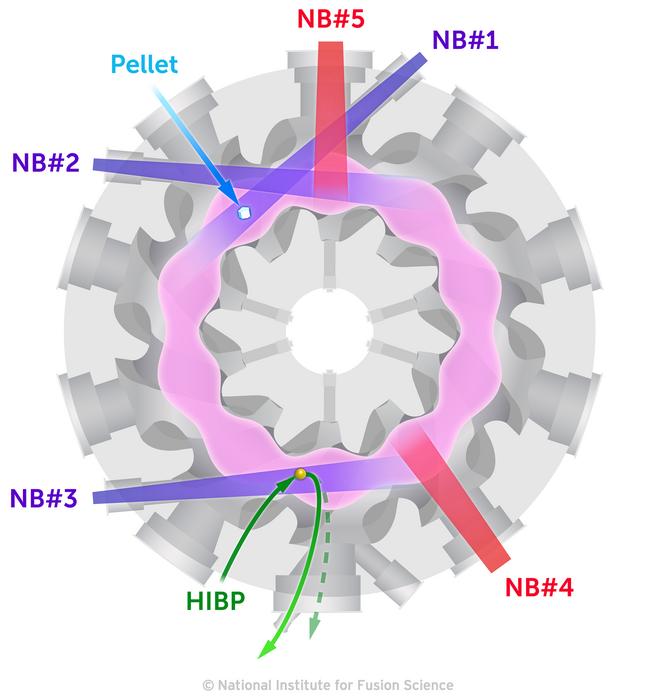Background

Credit: National Institute for Fusion Science
Background
In the realm of fusion research, the control of plasma density, temperature, and heating is crucial for enhancing reactor performance. Effective confinement of plasma particles and heat, especially maintaining high density and temperature at the core where fusion occurs is essential. In the Large Helical Device (LHD)*1, challenges persist as the electron density profile often remains flat or even depressed at the center, complicating effort to sustain high central density.
Results
The LHD is equipped with five neutral beam (NB) injectors*3 for plasma heating. Injectors NB#1 to NB#3, deliver beams tangentially to the magnetic field, while NB#4 and NB#5 inject beams perpendicularly (see Figure 1). Despite variations in the power ratio between tangential and perpendicular injections, the ion temperature profile remained unchanged. However, Figure 2 illustrates the existence of both peaked (red and green) and flat (blue) electron density profiles.
Adjustments in the tangential to perpendicular energetic ion ratio alter the velocity distribution*4 from isotropic to anisotropic. We explored how density profile depends on the state*5 of these energetic ions by analyzing the ratio of the stored energies in the perpendicular and parallel components, designated as En⊥/En|| from the injected beam power of NB#1 – NB#5 (refer to Figure 3). Modifying the anisotropy within a range from En⊥/En|| = 0.3 to 0.8, showed that En⊥/En|| < 0.4 led to a flat electron density profile, while En⊥/En|| > 0.4 resulted in centrally peaked electron density profiles. Subsequently, the density profile of carbon ions was examined by externally injecting carbon and observing the ion behavior. The profile was centrally depressed in the conventional experimental range of En⊥/En|| < 0.4, yet peaked in the new experimental range where En⊥/En|| > 0.4.
These findings suggest that the plasma inflow/outflow rates change spontaneously with the presence of energetic ions. Further investigations into the effects of energetic ions were conducted using simulation calculations. Initially, we analyzed the electric field in the radial direction at the plasma core, which simulated -5 kV/m, consistent with measurements from the heavy ion beam probe*6 (HIBP depicted in Figure 1). Although an electric field of this strength is unlikely to influence particle flow significantly, further analysis of particle inflow and outflow due to turbulence*7 was conducted. The results suggest that turbulence may influence both peaked and flat density profiles.
Significance of research results and future developments
This discovery elucidates that the direction and volume of particle inflow and outflow within the confinement region of fusion plasma can be effectively regulated by applying the anisotropic nature of energetic ions, thereby keeping the plasma in an optimal state. In the future, the new physics mechanism behind this must be clarified. We will then further develop our research to contribute to higher performance of fusion reactor plasmas, downsizing of fusion reactors, improvement of energy output, and control of plasma burning conditions.
[Glossary]
*1 Large Helical Device (LHD): The LHD is one of the world’s largest helical superconducting plasma experimental devices, housed at the National Institute for Fusion Science in Toki City, Gifu Prefecture, Japan.
*2 High-energy ions: These ions, generated from heated beams in environments where the plasma temperature reaches approximately 100 million degrees, possess energies about 10-20 times higher than their ambient conditions.
*3 Neutral beam injection heating system: This system heats plasma, which comprises electrons and ions, using a high-energy, electrically neutral hydrogen beam. Upon injection, the beam collides with the plasma particles, effectively raising the plasma temperature.
*4 Velocity distribution: A plasma consists of positively and negatively charged particles. These particles confined by a magnetic field exhibit unique movements as they spiral along magnetic field lines, differing in their motion in parallel and perpendicular directions to these lines. The velocity distribution within the plasma is described as isotropic when the particle velocities are uniform both parallel and perpendicular to the magnetic field lines at a given spatial location. Conversely, the distribution is termed anisotropic when neutral beam injectors NB#1 to NB#3, which are aligned tangentially, are employed, they induce a population of particles with elevated velocities parallel to the magnetic field lines, as depicted in Figure (b). Conversely, when NB#4 and NB#5, which are aligned perpendicularly, are activated, they generate a population of particles with elevated velocities perpendicular to the magnetic field lines, as illustrated in Figure (c).
*5 Energetic ion states: Adjusting the ratio of particle distributions with velocities perpendicular and parallel to the magnetic field lines enables the ions to switch between isotropic and anisotropic states. This experiment focused on varying the anisotropic state.
*6 Heavy ion beam probe (HIBP): The HIBP, employing a gold ion beam, is utilized to measure the electric potential within a plasma, providing critical diagnostics.
*7 Turbulence: In conditions where plasma density and temperature are nonuniform, turbulence arises. This results in the growth of plasma waves, leading to the formation of flows and vortices, often manifesting as irregular and turbulent movements at high temperatures.
[Acknowledgments]
This research was supported by Grants-in-Aid for Scientific Research (B) (No. 23H01160, 23K25857, 2023-2025) and the Promotion of Joint International Research (Fostering Joint International Research(B)) (No. KA19KK0073, 2019-2023).
Journal
Physics of Plasmas
Method of Research
Experimental study
Subject of Research
Not applicable
Article Title
Core density profile control by energetic ion anisotropy in LHD
Article Publication Date
5-Jun-2024



